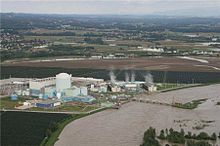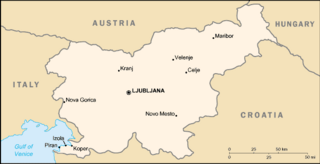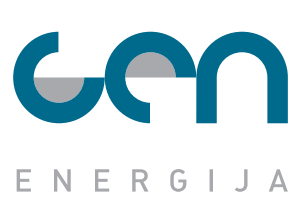Nuclear energy is used in Slovenia for a number of civilian purposes including electricity production, medicine, and research. [1]
Nuclear energy is used in Slovenia for a number of civilian purposes including electricity production, medicine, and research. [1]
As stated in the Slovenian 8th National Report as Referred in Article 5 of the Convention on Nuclear Safety, “[t]he most prominent piece of legislation is the Act on Protection against Ionising Radiation and Nuclear Safety – ZVISJV 1 (Official Gazette of the Republic of Slovenia, No. 76/17 and 26/19; hereinafter referred to as “the 2017 Act”), which entered into force in January 2018. The previous Act was adopted in 2002 and subsequently revised four times. After the adoption of the 2017 Act substantial work was devoted to updating the whole set of secondary legislation (the so-called Rules), which is practically finished, as of May 2019.” [1]
The Slovenian nuclear regulator is the Slovenian Nuclear Safety Administration (SNSA). SNSA is located in a modern office park on the northern edge of the Slovenian capital of Ljubljana at Litostrojska 54, 1000 Ljubljana. As of 2019, the SNSA is part of the Ministry of the Environment and Spatial Planning. [1]
Slovenia is a signatory to the International Atomic Energy Agency Convention on Nuclear Safety. The Convention seeks to improve transparency and adherence with a “high level of safety by establishing fundamental safety principles to which the States would subscribe.” [2]
Slovenia is also a member of the Nuclear Energy Agency (NEA), an intergovernmental agency that is organized under the Organisation for Economic Co-operation and Development (OECD), and European Atomic Energy Community - commonly known as Euratom.
The Jožef Stefan Institute (IJS) (Slovene : Institut "Jožef Stefan") is the largest research institute in Slovenia. The institute was founded by the State Security Administration (Yugoslavia) in 1949 for atomic weapons research. Today the main research areas are physics, chemistry, molecular biology, biotechnology, information technologies, reactor physics, energy and environment. The institute has facilities in two locations. The main facilities and the headquarters are on Jamova 39 in Ljubljana, the other location is the Institute's Reactor Center Podgorica located in Brinje, Dol pri Ljubljani near Ljubljana.
The institute's Reactor Center Podgorica is home to a pool type research reactor. The General Atomics TRIGA Mark II reactor is rated for a nominal 250 kW thermal. The reactor was first licensed in 1966 and is expected to continue operation at least into the 2030s. [1]
The Central Radioactive Waste Storage of Slovenia is co-located at the Institute's reactor facility. This facility is used for storage of the low and intermediate level solid radioactive waste from the Reactor Center and other, non-Institute small waste producers such as medical, research, and industrial applications of ionising radiation. [1]

Slovenia's only nuclear power plant is the 696 MWe Krško Nuclear Power Plant, located in the eastern part of the country, which went into commercial operation on January 15, 1983. It was built as a joint venture by Slovenia and Croatia which were at the time both part of Yugoslavia. The plant is a Westinghouse Electric Company two loop, light water pressurized water reactor. The operating company Nuklearna Elektrarna Krško (NEK) remains co-owned by Slovenian and Croatian state-owned companies and provides more than one quarter of Slovenia's electrical power along with roughly a fifth of Croatia's. [1]
In 2019, the plant provided 22.3% of Slovenia's total energy supply. [3] The plant provided 36.2% of the total electricity generated in Slovenia in 2019. [4]
The debate on whether and when to close the Krško plant intensified following the 2005-06 winter energy crisis which highlighted Slovenia's exposure to natural gas supply disruptions. [5] Nuclear waste is disposed in storage facilities. Slovenia has left the possibility of reprocessing spent fuel open. [5]
The plant is expected to be operational until 2043, following agreement in 2020 between the Slovenia and Croatia governments. [6]
The idea of increasing the amount of electricity produced by nuclear power in Slovenia has been explored several times since the Krško nuclear power plant was constructed. As all liquid and gas fossil fuels (e.g. petroleum products and natural gas) for consumption in Slovenia must be imported, Slovenia is seeking greater energy independence, in addition to seeking to be carbon neutral by 2050. GEN Energija also cites nuclear as a means to help ensure affordable, predictable and stable prices of electricity for Slovenia as motivations for another reactor at the Krško site. [7] [8]
GEN Energija described planning efforts for a second Krško unit, JEK 2, on their website as early as 2015. [8] The parent company of the Slovenian owner of the plant, GEN Skupina, published a video in mid-2019 depicting a single new large reactor at the Krško site, to the west of the current reactor. Additionally, it was announced that GEN filed a request for a second reactor at Krško and was looking for Slovenian partners for the project. In the early 2020s, the Ministry of Infrastructure included the start of construction of an addition to the Krško nuclear power plant by the late 2020s in its plans, though no decision on reactor technology or final decision to proceed has been made. Croatia's government has also expressed interest in an expansion of the Krško nuclear power plant, in addition to the announced life extension of the operating Krško reactor to 2043. [9] [6]
In December 2020, Slovenia and the United States signed a Memorandum of Understanding Concerning Strategic Civil Nuclear Cooperation intended to improve cooperation on energy security and strengthens the diplomatic and economic relationship between the two countries. [10] The MOU was viewed as a reinforcement of the Slovenian-US ties in nuclear power which extend back to the start of construction of the US company Westinghouse-designed Krško nuclear power plant in 1975; observers noted that US technology would be considered for any nuclear expansion plans in Slovenia.
Based the GEN energij statement regarding the desired annual electrical generation of the new plant to be approximately 8.8 TWh, reactors with net electrical capacities of approximately 1,100 MWe would be considered. GEN energija mentioned following technologies to be considered for JEK 2 in 2021: [11]
Nuclear engineering is the engineering discipline concerned with designing and applying systems that utilize the energy released by nuclear processes. The most prominent application of nuclear engineering is the generation of electricity. Worldwide, some 440 nuclear reactors in 32 countries generate 10 percent of the world's energy through nuclear fission. In the future, it is expected that nuclear fusion will add another nuclear means of generating energy. Both reactions make use of the nuclear binding energy released when atomic nucleons are either separated (fission) or brought together (fusion). The energy available is given by the binding energy curve, and the amount generated is much greater than that generated through chemical reactions. Fission of 1 gram of uranium yields as much energy as burning 3 tons of coal or 600 gallons of fuel oil, without adding carbon dioxide to the atmosphere.

A nuclear power plant (NPP), also known as a nuclear power station (NPS), nuclear generating station (NGS) or atomic power station (APS) is a thermal power station in which the heat source is a nuclear reactor. As is typical of thermal power stations, heat is used to generate steam that drives a steam turbine connected to a generator that produces electricity. As of September 2023, the International Atomic Energy Agency reported that there were 410 nuclear power reactors in operation in 32 countries around the world, and 57 nuclear power reactors under construction.
The Jožef Stefan Institute (JSI) is the largest research institute in Slovenia. The main research areas are physics, chemistry, molecular biology, biotechnology, information technologies, reactor physics, energy and environment. At the beginning of 2013 the institute had 962 employees, of whom 404 were PhD scientists.

The Bataan Nuclear Power Plant (BNPP) is a nuclear power plant on the Bataan Peninsula, 100 kilometers (62 mi) west of Manila, Philippines. Completed but never fueled, it is located on a 3.57 km2 (1.38 sq mi) government reservation at Napot Point in Barangay Nagbalayong, Morong, Bataan. It was the Philippines' only attempt at building a nuclear power plant. It was mothballed due to safety concerns in the wake of the Chernobyl disaster in Ukraine in 1986 and issues regarding corruption.

The AP1000 is a nuclear power plant designed and sold by Westinghouse Electric Company. The plant is a pressurized water reactor with improved use of passive nuclear safety and many design features intended to lower its capital cost and improve its economics.
The electricity sector in Sweden has three operational nuclear power plants with 6 operational nuclear reactors, which produce about 29.8% of the country's electricity. The nation's largest power station, Forsmark Nuclear Power Plant, has three reactors producing 3.3 GW and 14% of Sweden's electricity.

In the United States, nuclear power is provided by 94 commercial reactors with a net capacity of 97 gigawatts (GW), with 63 pressurized water reactors and 31 boiling water reactors. In 2019, they produced a total of 809.41 terawatt-hours of electricity, which accounted for 20% of the nation's total electric energy generation. In 2018, nuclear comprised nearly 50 percent of US emission-free energy generation.

Nuclear power plants operate in 32 countries and generate about a tenth of the world's electricity. Most are in Europe, North America and East Asia. The United States is the largest producer of nuclear power, while France has the largest share of electricity generated by nuclear power, at about 70%.

The Krško Nuclear Power Plant is located in Vrbina in the City Municipality of Krško, Slovenia. The plant was connected to the power grid on October 2, 1981, and went into commercial operation on January 15, 1983. It was built as a joint venture by Slovenia and Croatia which were both part of Yugoslavia at the time.

China is one of the world's largest producers of nuclear power. The country ranks third in the world both in total nuclear power capacity installed and electricity generated, accounting for around one tenth of global nuclear power generated. As of February 2023, China has 55 plants with 57GW in operation, 22 under construction with 24 GW and more than 70 planned with 88GW. About 5% of electricity in the country is due to nuclear energy. These plants generated 417 TWh of electricity in 2022 This is versus the September 2022 numbers of 53 nuclear reactors, with a total capacity of 55.6 gigawatt (GW). In 2019, nuclear power had contributed 4.9% of the total Chinese electricity production, with 348.1 TWh.
Nuclear power in Romania provides around 20% of its electricity, with two nuclear reactors commencing operations in 1996 and 2007. In 2020, Romania generated a total of 56.1 TWh of electricity. The generation mix was composed of hydro (28%), nuclear (20%), natural gas (15%), coal (17%), wind (12%), solar (3%), and biofuels & waste. The Romanian government strongly supports nuclear energy.

Ukraine operates four nuclear power plants with 15 reactors located in Volhynia and South Ukraine. The total installed nuclear power capacity is over 13 GWe, ranking 7th in the world in 2020. Energoatom, a Ukrainian state enterprise, operates all four active nuclear power stations in Ukraine. In 2019, nuclear power supplied over 20% of Ukraine's energy.

The small modular reactor (SMR) is a class of small nuclear fission reactor, designed to be built in a factory, shipped to operational sites for installation and then used to power buildings or other commercial operations. The term SMR refers to the size, capacity and modular construction. Reactor type and the nuclear processes may vary. Of the many SMR designs, the pressurized water reactor (PWR) is the most common. However, recently proposed SMR designs include: generation IV, thermal-neutron reactors, fast-neutron reactors, molten salt, and gas-cooled reactor models.
The Netherlands' only commercial nuclear reactor is Borssele nuclear power plant, which became operational in 1973 and as of 2011 produces 485 MW and about 4% of the country's electricity.
Currently, Turkey has no operating commercial nuclear reactors. However, four VVER-1200 reactors at the Akkuyu Nuclear Power Plant, are currently under construction and expected to come online in 2025. The government is aiming for 20 GW of nuclear.

Total primary energy supply (TPES) in Slovenia was 6.80 Mtoe in 2019. In the same year, electricity production was 16.1 TWh, consumption was 14.9 TWh.
This is a history of nuclear power as realized through the first artificial fission of atoms that would lead to the Manhattan Project and, eventually, to using nuclear fission to generate electricity.

GEN energija, d.o.o. is a state-owned power company in Slovenia. It is the parent company in the GEN Group. GEN energija was established 2001 as Eles Gen, a subsidiary of Elektro-Slovenija, for holding Slovenian shares in the Krško Nuclear Power Plant. In February 2006 the company was separated from Elektro-Slovenija and it became directly owned by the state.
The Brestanica Thermal Power Plant is a natural gas and petroleum fueled power station in Brestanica, Slovenia. The plant is owned by GEN energija and operated by Termoelektrarna Brestanica Doo.